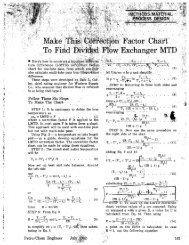Troubleshooting shell-and-tube heat exchangers - Gulley & Associates
Troubleshooting shell-and-tube heat exchangers - Gulley & Associates
Troubleshooting shell-and-tube heat exchangers - Gulley & Associates
Create successful ePaper yourself
Turn your PDF publications into a flip-book with our unique Google optimized e-Paper software.
<strong>Troubleshooting</strong> <strong>shell</strong>-<strong>and</strong>-<strong>tube</strong><br />
<strong>heat</strong> <strong>exchangers</strong><br />
Use these techniques <strong>and</strong> guidelines to<br />
ensure more reliable <strong>heat</strong> transfer<br />
D. <strong>Gulley</strong>, <strong>Gulley</strong> Computer <strong>Associates</strong>, Tulsa,<br />
Oklahoma<br />
It is stressful when <strong>exchangers</strong> go online <strong>and</strong> don't perform<br />
as they should. But not all scary things go "bump<br />
in the night." Heat <strong>exchangers</strong> that go onstream <strong>and</strong><br />
don't perform are also scary. This is especially true if<br />
there is a lack of thermal wells, pressure gages <strong>and</strong><br />
flowmeters. In addition, you are told that many hundreds<br />
of thous<strong>and</strong>s of dollars a day are being lost due to<br />
decreased production, so the problem has to be found<br />
immediately. In many cases, there has to be a shutdown.<br />
Here is helpful information on finding a cure, including:<br />
• What information to collect <strong>and</strong> what to look for<br />
• The importance of calculated pressure drops <strong>and</strong> how<br />
they help analyze the problem<br />
• Two-phase flow emphasizing low <strong>heat</strong> transfer due<br />
to stratified flow<br />
• Actual case histories of design <strong>and</strong> fabrication errors<br />
to help with the diagnosis.<br />
The concentration is on thermal problems; problems<br />
due to vibration <strong>and</strong> exchanger leaks are not discussed.<br />
INFORMATION COLLECTION<br />
Besides the obvious process information of flow, temperatures<br />
<strong>and</strong> pressure drops, you win probably need the<br />
manufacturer's <strong>heat</strong> exchanger drawings. Hopefuny, you<br />
will not have to run <strong>heat</strong> exchanger tests. But if you do,<br />
there are procedures in the literature.1, 2<br />
Using the collected process information, make a full<br />
thermal design computer run. The printout will have much<br />
more information than a st<strong>and</strong>ard specification sheet.<br />
Check the printout with the following in mind:<br />
1. Are there any error messages about the physical<br />
properties used?<br />
2. Are there error messages for the input data?<br />
3. Check the section that analyzes the design for comments.<br />
This is a section of the program that acts as expert<br />
system software.<br />
4. Was the correct <strong>heat</strong>-transfer type specified on input?<br />
--- ---<br />
Fig. 1. Stratified flow pattern.<br />
5. Have any warnings been ignored in the <strong>heat</strong><br />
exchanger's design?<br />
6. Was the advice on bundle-sealing devices followed?<br />
7. Ifthe problem is freezing or <strong>heat</strong> damage, could the<br />
temperatures in the clean condition be the problem?<br />
In some cases, it is helpful to measure temperatures<br />
on the exchanger's exterior. This can identify unvented<br />
gas, stratified flow or fluid bypassing. Ifthese temperatures<br />
are not too hot or cold, you can check the <strong>shell</strong> by<br />
feeling with your h<strong>and</strong>s.<br />
Pressure drops. These are a big help in analyzing performance<br />
problems. They also provide a rough check of<br />
flowrates. Single-phase streams should check reasonably<br />
close between calculated <strong>and</strong> measured pressure drops if<br />
there isn't a fouling problem. Two-phase pressure drops<br />
will be reasonably close if they are zoned <strong>and</strong> flow patterns<br />
are considered.<br />
Measured pressure drops lower than calculated drops<br />
indicate fluid bypassing. A low pressure drop on the <strong>tube</strong>side<br />
means that not all the flow is entering the <strong>tube</strong>s that<br />
should. There may be a problem where the channel pass<br />
plates or floating head pass plates meet the <strong>tube</strong>sheets.<br />
The bundle should be pulled <strong>and</strong> the pass plates <strong>and</strong><br />
<strong>tube</strong>sheet gasket examined. It could be a corrosion problem,<br />
gasket problem or a manufacturing defect.<br />
A <strong>shell</strong>side pressure drop lower than calculated indicates<br />
improper bundle sealing. Bundle bypass streams<br />
lower <strong>heat</strong> transfer. Any open areas above or below the<br />
bundle should have the crossflow component of flow<br />
blocked by seal strips. This is especially important for<br />
the laminar flow region. Ifthe exchanger is a two <strong>shell</strong>pass<br />
type, fluid is probably bypassing the long baffle ifit<br />
is not welded in. Long baffles with leafseals do not give<br />
a perfect seal. These thin strips of metal cannot take<br />
much punishment. Sometimes they are damaged in fabrication.<br />
Leaf seals can also be damaged at the plant<br />
HYDROCARBON PROCESSING / SEPTEMBER 1996 91




